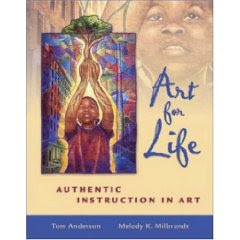Author(s): Doug Blandy, Ernest Pancsofar, Tom Mockensturm
Source: Art Education, Vol. 41, No. 1, Teaching Art (Jan., 1988), pp. 60-66
Published by: National Art Education Association
Stable URL: http://www.jstor.org/stable/3194135
Accessed: 19/08/2009 23:05
“This article will propose six guidelines for art educators working with children and youth experiencing significant mental and physical challenges.”
“The guidelines assume that art specialists in local schools will identify content that is considered to be of value for all students, including those experiencing significant mental/physical challenges.”
Guideline One: The Use of Age- Appropriate Materials
“The art specialist should select materials and experiences that are chronologically age-appropriate to substitute for those of earlier years.”
“With some creativity, an art specialist can modify a seemingly inappropriate situation or material to a student's satisfaction and allow the student to be perceived as a more competent individual.”
Guideline Two: Incorporate the Principle of Partial Participation
“This guideline is directed to students who fail to complete all the steps of an activity and where individualized assistance has not resulted in expected gains.”
“I. Conduct a non-disabled person inventory by evaluating the performance of a non-disabled peer in a given art activity.”
“II. Conduct a significantly mentally/physically challenged student inventory by evaluating the performance of the student having difficulty with the art activity. This inventory should take careful note of what the student can and cannot do.“
“III. Determine the skills that the student with challenges can probably acquire. This determination can be made by looking at what the student can presently do; considering the student's history; talking with other teachers and significant others in the student's life; and by talking with the student.”
“IV. Determine the skills associated with the activity in question which the student probably cannot acquire by using the strategies listed in III.“
“V. Given the information obtained in I. through IV., generate several hypotheses as to how the activity can be adapted for the student.“
“VI. Inventory the skills associated with the adaptations using a non-disabled peer.”
“VII. Based on those adaptations which seem possible, choose an individualized adaptation by considering the information obtained in III., IV., and VI.”
“VIII. By referring to IV. determine which skills can now be acquired through the use of the adaptation.”
Guideline Three: Development of a Cue Hierarchy
“Cues should be graduated with the least amount of intervention by the art specialist followed by a greater amount in those cases where a student fails with the lesser intervention.”
“Each student's cue hierarchy should be included in the Individualized Education Plan and attached to all correspondence to art educators who provide intermittent services to the students.”
Guideline Four: Analysis of Current and Subsequent Environments
“Survey questions can address the availability of art materials and work space in the home, the hobbies of family members, leisure activities, knowledge, attitudes, values, and beliefs about art, and the family's use of community art resources.”
“Once this relationship is established it can be periodically reinforced through informal telephone conversations, classroom produced newsletters, teacher/parent/student conferences, home visits, and the Individual Education Plan conference.”
Guideline Five: Attention to Multi-Cultural Issues in Art Education
“Students with significant mental/physical challenges must also participate in art education programs that recognize and celebrate ethnic, racial, occupational, regional, religious, generational, and other multi-cultural influences.”
Guideline Six: Participation in the Greater Art Community
“I. Encourage your students to participate in local, regional, national, and international juried and un-juried exhibits which are not specifically for people with disabilities.”
“II. In your capacity as an art specialist act as an advocate for the programmatic and physical accessibility of art museums, cultural art centers, galleries, and other arts institutions.”
“III. Encourage your students to become members of art institutions and interest groups.”
“IV. Link your students to the art community through trips to art institutions and art openings and by subscribing to local, regional, national, and international art publications.”
“V. In your capacity as an art specialist, seek memberships on local, regional, national, and inter-national curriculum committees and advocate for non-segregating programs for people with disabilities.”
Subscribe to:
Post Comments (Atom)






No comments:
Post a Comment